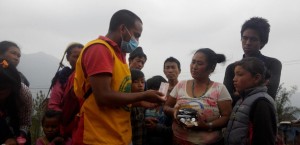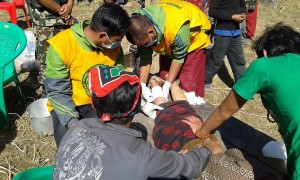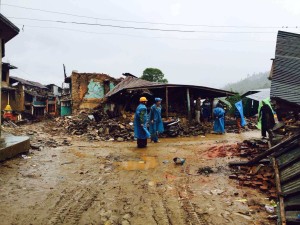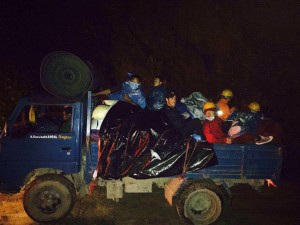A Personal Report on Shechen’s Relief Program
May 31st, 2015 | Published in NEWS
The leader of Shechen’s Eco Group talks about his personal experiences as part of one of the first Shechen earthquake relief teams. Lopon Tsering Rahul graduated from Shechen Monastery’s Shedra (College) in 2013. He is the leader of our Eco Group, which includes earthquake preparedness. He was part of all the first aid and earthquake preparedness training workshops held at Shechen over the past few years.On May 16th, he told us about his experience with the first two outreach teams he headed.
April 25th was the last day of a series of wangs (empowerments) at Shechen Monastery. We had been arranging everyone into lines for the empowerment in the courtyard (about 4000 people) when the earthquake started. I went right toward the temple because I was afraid everyone inside the temple would panic. Thankfully most people inside the temple sat down and waited for the shaking to stop. Right then, the front archway at the top of the stairs to the temple courtyard started to topple.
Lucy Needham and the first aid group opened the earthquake storage shed, where we stored the tools, medicine, food, water, and equipment. Lucy is a long-time friend of the monastery and resident of Kathmandu, who had initiated the earthquake preparedness program at Shechen in 2012. We used the loudspeakers from the shed to request people not to panic. Many people came to the monastery grounds and in the evening we arranged for them to have a place to sleep and offered food to everyone. There were 2-3,000 people but we only had 20 blankets in the shed, so we tried to gather whatever we could from our rooms.
On the second day we looked after the large group of people at the monastery, and once that seemed stabilized, we explored the situation outside, first going to Kopan with first aid equipment. We were able to give people medicine, some basic care, and dressings for small cuts and wounds.
On the third day, we went out to supply drinking water to those areas with water shortage, including Tashi Orphanage, where we also took rice and dahl. We were accompanied by one of the Shechen Clinic’s doctors who did check up’s on the children.
 It was then decided that we should go to places where people were more in need, outside of Kathmandu Valley. Gorkha seemed in the most danger but it was un-passable. After that, the place most in need was Nuwakot, so that is where Shechen Eco Group and the first aid group members went. As we didn’t have previous experience with outreach, Khenpo Shelnang contacted Share-Nepal (Nyano Sansar). They helped us a lot on this first trip and helped make arrangements and permissions for us. We took their supplies to provide relief, food, rice, and medicine.. We had 50 people on our team, lamas, ex-lamas, art school members, female volunteers, and four doctors.
It was then decided that we should go to places where people were more in need, outside of Kathmandu Valley. Gorkha seemed in the most danger but it was un-passable. After that, the place most in need was Nuwakot, so that is where Shechen Eco Group and the first aid group members went. As we didn’t have previous experience with outreach, Khenpo Shelnang contacted Share-Nepal (Nyano Sansar). They helped us a lot on this first trip and helped make arrangements and permissions for us. We took their supplies to provide relief, food, rice, and medicine.. We had 50 people on our team, lamas, ex-lamas, art school members, female volunteers, and four doctors.
Samari
We traveled by night to the district of Samari. It was a very difficult trip, one of the most difficult situations of my life. It was raining and there were landslides. The roads were badly damaged, some parts destroyed. In some areas houses had collapsed across the road and we had to drive over the rubble. One of our cars broke down, so we had to take some of our supplies and continue on foot with backpacks. We walked to the main chowk of Samari and stayed at the police station for the night.
The next day we spoke with the police, cooked, and shared food together. They had set up a medical camp and asked the doctors to stay to help. Since we had 40-50 monks in our team, by dividing everyone into groups of 3 and 4 we were able to send small teams to all the villages to take supplies and assess what was needed: it is a big VDC (Village Development Committee or district), comprised of 9 villages, with 2,500 people.
The four doctors, a French nurse, and 6-7 first aiders did more than 400 checkups that day, with our monks assisting with first aid. When the villagers heard about us being there, many came. We realized how many people with wounds and other injuries there were. Those monks who had taken advanced first aid training had learned a bit about supplying medicines too. We managed to treat people and distribute what we had.
It was really hard to see how much they needed, especially the poorest, and we didn’t have enough supplies to give everyone all that they needed. Fortunately, the government arrived with some much-needed supplies.
It had started to rain and we were concerned about landslides. Khenpo Shelnang arranged for more supplies to be sent to us. I felt that it was too risky for all of us to stay, so 14 of us stayed, those who volunteered to do so, along with 3 of the doctors. From there we were able to access Samundratar by vehicle with supplies from Share-Nepal and from some Kargyu monks.
Ghyangpedi
We left 7 people in Samundratar to do more reconnaissance and the rest went on to Ghyangpedi. The rescue police hadn’t visited that location yet. We carried supplies, medicine, and food. The road was rough and had been blocked by landslides, with rocks still falling in some spots. We weren’t afraid and felt inspired to help, but the place we reached that evening was scary. There were landslides on each side of the road and the road had big crevasses through it.
In the next village, people had pneumonia, cuts and large wounds, some with bad infections, even some with insects inside the wounds. We had done some dressings before, but none like this and we had only one doctor with us.
The army arrived and said they were also setting up medical camps in various locations, but their medicine had run out. The army asked us to visit 2 or 3 other villages as they only had enough supplies for one. So we went to Gyewar, Village No. 8 and Sissifu, Village No. 6. The conditions were the same. Many people had died, the wounds were terrible and some people had broken limbs. People were crying and making funerary pujas. Some were asked if they wanted to be airlifted but they didn’t want to go without their relatives. They’d rather die in their village than go alone. I was very moved by the courage and attitude of these people.
We were short of medicine, dressings, supplies, and yet there were so many injured people. We had no phone to contact anyone for more supplies. As we left it began to rain and it was incredibly scary to pass back over these roads. When we got back to the others in our group, we were simply happy that we had survived.
In those villages every building was destroyed. Yet all the villagers worked together so well and tried to remain in harmony and stayed in camps together. The Red Cross had given one or two tents and they had removed tin from roofs to make temporary shelters. They exhibited a high degree of self-sufficiency and determination to help and rebuild. We were very moved and impressed by these people.
Rasuwa
On this second trip, we visited places where people had already received some aid and we had a doctor with us. In the village of Fikuri, we met a few people from the villages in Rasuwa. The memory of them has made a deep impression on me. Their situation was so bad. Everything had been demolished and the earth had cracked open. It was totally uninhabitable, with continuing landslides. We met a shepherd from Rasuwa who had traveled by foot with his goats and sheep for 9 days to charge his cell phone so that he could communicate with his village. We told him to have people from the village come for supplies. We waited there for 3 days for them to reach us.
Altogether we visited about 10 villages. Those who had received no aid were moved from the heart, cried, and were so grateful for everything that they received. We were at the camp getting ready to return to Kathmandu when the second big earthquake struck on May 12th . Our team continued to work after that too.
General Comments
May 28:
Now that the emergency stage is over, in the second relief phase, the monastery will channel its outreach in different ways, and through other organizations and NGOs. Our monks also have to help with the rebuilding of our badly damaged monastery and the care of our monks and local population.
Our training as Buddhist monks is to care for others, to do pujas for others, but this work has been the actual practical side. This is also what Dilgo Khyentse Yangsi Rinpoche said (see the video). We don’t need to be recognized for our work, not at all, but it would be nice to inspire others. We never talk about our religion or outreach. We are all human beings, which is why we are helping. We cannot remove their suffering; the kilos of rice won’t do that, but we do hope that we can help to relieve their suffering a little.
Translated by Marina Lama, transcribed and edited by Charlotte Davis and Juanita Evans.



